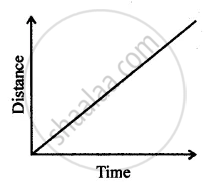Advertisements
Advertisements
Question
The numerical ratio of displacement to distance for a moving object is :
Options
always less than 1
equal to 1 or more than 1
always more than 1
equal to 1 or less than 1
Solution
equal to 1 or less than 1
i.e., Equal to 1 or less than 1.
Displacement is always smaller than or equal to displacement.
RELATED QUESTIONS
How is the distance related with time for motion under uniform acceleration such as the motion of a freely falling body?
A body is moving in a straight line and its displacement at various instants of time is given in the following table
| Time (s) | 0 | 1 | 2 | 3 | 4 | 5 | 6 | 7 |
| Displacement (m) | 2 | 6 | 12 | 12 | 12 | 18 | 22 | 24 |
Plot the displacement-time graph and calculate
(i) Total distance travelled in the interval 1 s to 5 s.
(ii) Average velocity in time interval 1 s to 5 s.
A car travels a distance 100 m with constant acceleration and average velocity of 20 ms-1. The final velocity acquired by the car is 25 ms-1.
Find
(i) The initial velocity.
(ii) Acceleration of the car.
Can you suggest the kind of motion of a body from the following distance – time graph?

Write two differences between distance and displacement.
Assertion: Displacement of a body may be zero when distance travelled by it is not zero.
Reason: The displacement is the shortest distance between initial and final position.
Write a note on the following:
Nautical mile
Slope of a velocity-time graph gives
The displacement of a moving object in a given interval of time is zero. Would the distance travelled by the object also be zero? Justify your answer.
The displacement covered by the second hand of radius V in a clock after one revolution is ______.
